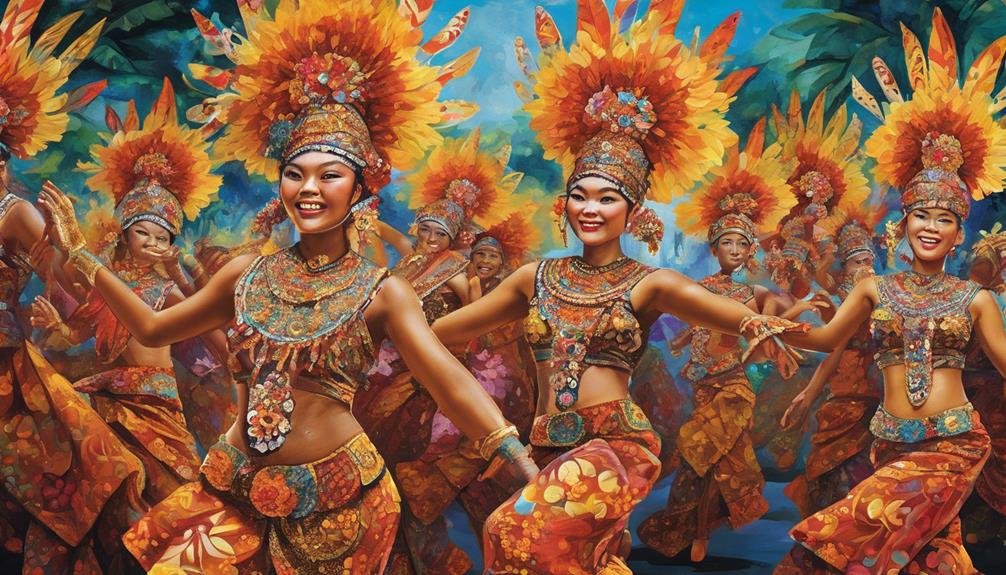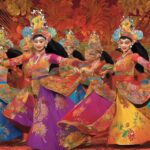Immerse yourself in Indonesia's Solo Batik Carnival, a vibrant cultural extravaganza on Slamet Riyadi Street. Witness a dazzling showcase of intricate batik designs and costumes, each portraying unique themes like traditional masks and Keajaiban Legenda. The carnival preserves Indonesia's cultural heritage through this artistic celebration, recognized by UNESCO. Skilled artisans create mesmerizing batik motifs, reflecting stories of symbols and beliefs. Dance performances and parades add dynamism, uniting diverse cultural groups. Discover the fusion of tradition and modernity, promoting local craftsmanship and community unity. Explore the evolving world of batik artistry and its impact on tourism and the local economy.
Key Takeaways
- Annual cultural celebration in Solo, Indonesia.
- Showcases vibrant batik designs and costumes.
- Highlights traditional and modern artistic expressions.
- Features energetic dance performances and parades.
- Promotes cultural unity, heritage preservation, and community engagement.
Overview of Solo Batik Carnival
The Solo Batik Carnival, held annually on Slamet Riyadi Street in Solo, Indonesia, is a vibrant cultural celebration that brings together people from various sectors of society to showcase their artistic expressions through an array of batik designs and costumes. This carnival isn't just a parade; it's a lively display of creativity and tradition, where participants use a variety of materials to craft intricate costumes that go beyond traditional batik fabric.
Each year, the streets come alive with a burst of colors and patterns as participants flaunt their unique creations, drawing inspiration from themes like traditional masks, Sekar Jagad, and Keajaiban Legenda. The 2023 edition of the Solo Batik Carnival took it a step further by highlighting the theme Hastha Sawanda, which incorporated 8 normative provisions to inspire captivating dance performances. This event isn't only a visual feast but also a platform for individuals to express themselves through the rich cultural heritage of batik in Indonesia.
Cultural Significance of Batik
Batik holds immense cultural significance in Indonesia, with its intricate designs preserving the country's heritage and diverse cultural influences.
This traditional art form not only serves as a fashion trend but also as a symbol of status, identity, and cultural pride during special occasions and ceremonies.
Recognized by UNESCO as a Masterpiece of Oral and Intangible Heritage of Humanity, Indonesian batik showcases its global cultural importance and unique regional styles that reflect local traditions and stories.
Batik Heritage Preservation
What makes Batik such a revered and cherished art form in Indonesian culture?
The preservation efforts surrounding Batik play a vital role in its significance. This traditional art form, with its intricate artistic techniques of wax-resist dyeing, holds a special place in Indonesian heritage.
Recognized by UNESCO as a Masterpiece of Oral and Intangible Heritage of Humanity in 2009, Batik motifs tell stories reflecting cultural symbols, local beliefs, and historical influences. Skilled artisans meticulously apply wax and dyes multiple times, showcasing their expertise and dedication to retaining the essence of Batik.
Through these preservation endeavors, Batik continues to symbolize Indonesia's rich heritage, identity, and artistic expression, ensuring its legacy for future generations.
Batik Fashion Trend
Exquisite patterns and vibrant colors intertwine in the cultural fabric of Indonesian fashion, where Batik holds a revered place as a symbol of heritage and tradition. Batik craftsmanship shines through in the intricate designs and motifs that adorn the fabric, showcasing the skilled artistry passed down through generations.
This traditional technique hasn't only preserved cultural heritage but also inspired fashion innovation. Designers are constantly pushing boundaries, merging traditional Batik with modern styles to create unique and contemporary pieces. The adaptability of Batik fabrics allows for a seamless blend of traditional and modern clothing, appealing to a wide audience.
The evolution of Batik fashion trends demonstrates the timeless appeal and significance of this cultural art form in the global fashion landscape.
Batik Global Recognition
Amidst the diverse landscape of global fashion, the cultural significance of Batik shines as a beacon of traditional craftsmanship and heritage. Recognized as a Masterpiece of Oral and Intangible Heritage of Humanity by UNESCO in 2009, Batik holds immense global recognition.
Its intricate patterns not only showcase Indonesia's diverse cultural heritage but also serve as a form of cultural diplomacy. Each motif woven into Batik fabric carries specific meanings and traditions, making it a symbol of Indonesian identity and pride.
Beyond borders, international fashion designers have embraced Batik, incorporating its fabrics into their collections and enhancing its global appeal. Through the art of Batik, a beautiful fusion of tradition and modernity, the world witnesses a representation of cross-cultural understanding and appreciation.
Evolution of Batik Designs
As batik designs have evolved at the Solo Batik Carnival, a diverse array of materials beyond traditional fabric now feature prominently in the participants' creations. Innovative techniques and creative fusion are at the forefront of this evolution, with participants pushing boundaries by incorporating elements like cloth, cardboard, and decorations into their batik outfits. This creative exploration not only adds a fresh and dynamic dimension to the festival but also showcases the adaptability of traditional batik artistry to contemporary expressions.
The progression of batik designs reflects a continuous exploration of traditional patterns and motifs reinterpreted in modern contexts. Solo Batik Carnival serves as a platform where traditional batik techniques are fused with modern approaches, highlighting the versatility and enduring appeal of this cultural heritage. The festival's emphasis on blending the old with the new demonstrates how batik remains an essential medium for artistic expression and cultural celebration, resonating with both local and global audiences.
Participants and Performances
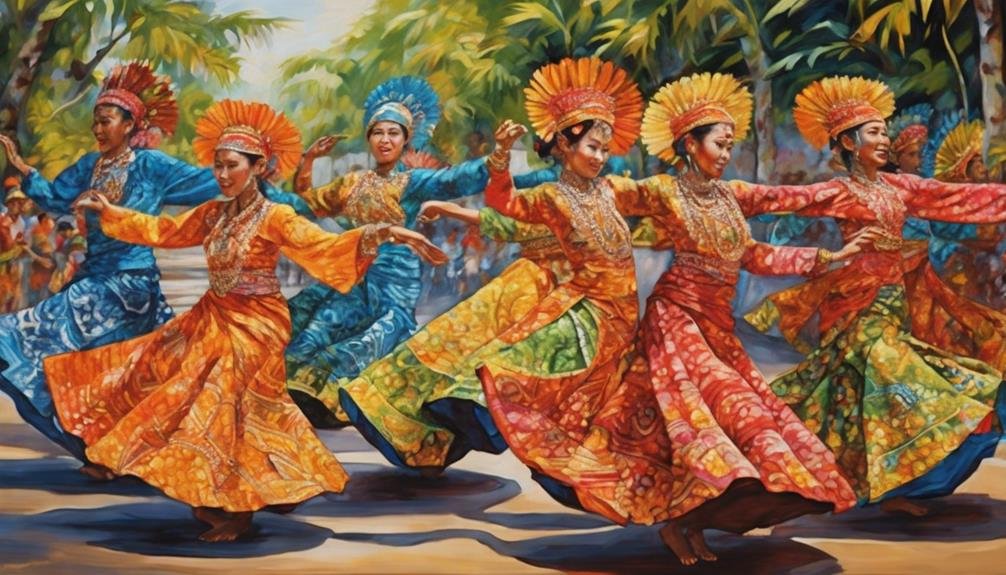
You'll be amazed by the diverse cultural representation at the Solo Batik Carnival, with participants like RF Solo and paskibraka SMAN 7 Solo showcasing their unique traditions.
The vibrant and colorful traditional costumes worn by the participants add a mesmerizing visual element to the carnival, celebrating Indonesia's rich heritage.
Get ready for energetic dance performances that infuse the carnival with a dynamic and lively atmosphere, capturing the essence of creativity and cultural pride.
Diverse Cultural Representation
Diverse cultural representation shines through the array of participants and performances showcased at the Solo Batik Carnival Indonesia, highlighting the rich fabric of Indonesia's heritage and traditions. Various cultural groups and organizations like RF Solo, paskibraka SMAN 7 Solo, and others participate, contributing to a vibrant mosaic of traditions and arts celebrated in Solo. The performances range from traditional dances such as Reog Kendang and Seblang Olehsari to modern interpretations of Indonesian culture, showcasing a beautiful blend of cultural exchange and artistic fusion. This cultural amalgamation is a reflection of the diverse and colorful heritage of Indonesia, engaging audiences with a mesmerizing display of traditions and creativity.
| Cultural Group | Performance | Contribution |
|---|---|---|
| RF Solo | Traditional Dance | Showcasing traditional Javanese heritage |
| Paskibraka SMAN 7 | Modern Fusion | Presenting a contemporary take on culture |
| Various Groups | Mixed Performances | Highlighting the diversity of Indonesian arts |
Colorful Traditional Costumes
With their vibrant colors and intricate designs, the traditional costumes worn by participants at the Solo Batik Carnival showcase the rich heritage of Indonesia's batik culture.
- Batik craftsmanship shines through in the intricate details of each costume, reflecting the expertise of the artisans.
- Cultural fusion is evident in the unique interpretations of traditional attire, blending modern influences with age-old practices.
- Each costume tells a story through elaborate patterns and motifs, capturing the essence of Indonesia's diverse cultural fabric.
- The combination of music, dance, and these meticulously crafted traditional costumes creates a visually enchanting experience for spectators, immersing them in the beauty and creativity of Indonesia's batik heritage.
Energetic Dance Performances
Energetic dance performances at the Solo Batik Carnival 2023 showcased the dynamic and diverse cultural heritage of Indonesia through engaging movements and expressions. With 378 participants from various cultural groups, the carnival was a vibrant display of cultural fusion.
RF Solo and paskibraka SMAN 7 Solo delivered lively routines, while performances like Reog Kendang, Seblang Olehsari, and Sendratari Menak Rengganis Widaninggar entertained the spectators. Kereta Pangeran Soengenep, with around 50 performers, stood out with a dance highlighting the event's cultural richness.
These performances aimed to capture the theme 'Hastha Sawanda' through captivating movements and expressions, immersing the audience in the lively spirit of Indonesian heritage.
Parade Highlights and Displays

Spectacularly showcasing vibrant batik designs, the Solo Batik Carnival parade route typically spans from Jl. Bhayangkara to Balaikota Surakarta. The parade is a visual feast for attendees, featuring a myriad of artistic expressions and vibrant displays. Here are some highlights from the carnival displays:
- Costume Creativity: Participants don intricately designed costumes that blend traditional elements with modern flair, showcasing the creativity and innovation in batik fashion.
- Cultural Fusion: The carnival serves as a melting pot of cultures, with various groups coming together to celebrate Indonesia's rich heritage through dance, music, and art.
- Diverse Defiles: The parade features four distinctive defiles, each with its unique story and performance, adding depth and diversity to the overall carnival experience.
- Notable Performances: Witness enthralling performances like the Kereta Pangeran Soengenep from Madura, which further enrich the cultural diversity of the procession.
Immerse yourself in the kaleidoscope of colors, sounds, and movements that make the Solo Batik Carnival a truly unforgettable experience.
Community Engagement and Unity
You'll find that the Solo Batik Carnival celebrates the rich fabric of cultural diversity, showcasing collaborative artistic expressions that transcend boundaries and unite communities.
The fusion of various backgrounds in creating intricate batik designs emphasizes the power of collective creativity and shared heritage, fostering a sense of togetherness and pride.
Through community engagement and unity, this event not only promotes cultural appreciation but also strengthens the bonds that tie the people of Solo together.
Cultural Diversity Celebration
How does the Solo Batik Carnival Indonesia promote community engagement and unity through the celebration of cultural diversity?
The carnival achieves this by involving participants from various backgrounds in showcasing the artistry of batik outfits. Through the celebration of Solo's rich batik heritage, people come together to honor and appreciate the cultural unity that batik represents.
Here are some key points to highlight this aspect:
- Involving participants from diverse ethnicities, ages, and professions
- Fostering unity by celebrating Solo's batik heritage
- Encouraging creativity and independence among participants
- Instilling pride in Solo's cultural identity and heritage
The Solo Batik Carnival serves as a platform for celebrating and embracing the diversity of Indonesian culture and traditions.
Collaborative Artistic Expressions
Celebrating the diverse cultural heritage of Solo through collaborative artistic expressions fosters community engagement and unity among participants of varied backgrounds. The Solo Batik Carnival showcases the power of collaborative creativity, where individuals from different ethnicities, ages, and professions come together to celebrate Solo's batik heritage through community artistry. Participants adorn themselves in diverse batik outfits, symbolizing the essence of creativity and independence within the community.
Promotion of Local Heritage
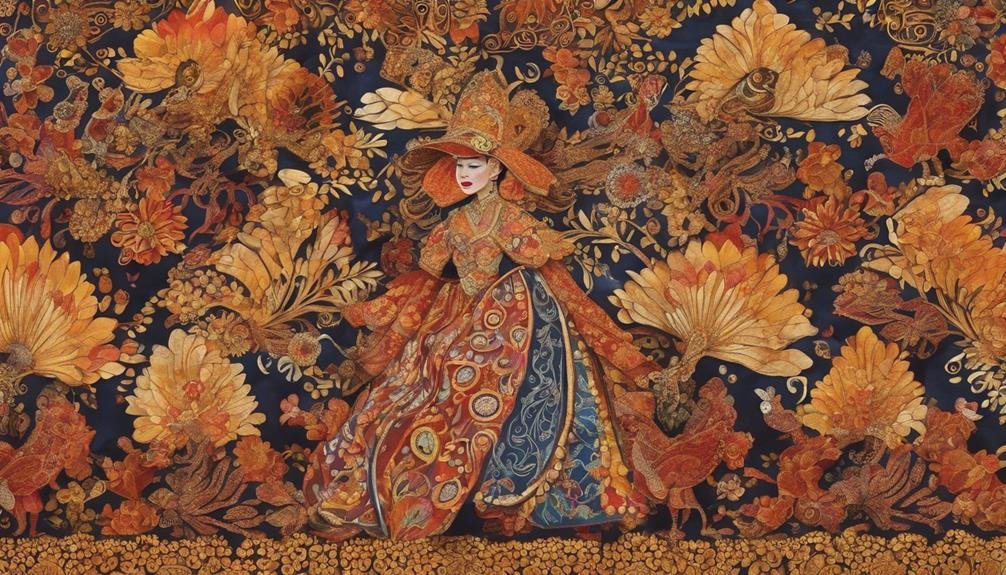
What role does the Solo Batik Carnival play in promoting the rich heritage of Solo through showcasing authentic batik designs?
The Solo Batik Carnival serves as a vibrant platform for celebrating local craftsmanship and heritage appreciation. Through this colorful event, the essence of Solo's cultural identity is vividly displayed, highlighting the intricate artistry and historical significance of Indonesian batik.
Here's why the promotion of local heritage through the carnival is so impactful:
- Preservation of Tradition: The carnival underscores the importance of preserving traditional batik-making techniques handed down through generations.
- Cultural Pride: Participants proudly don batik attire, fostering a deep sense of cultural pride and appreciation for Solo's rich heritage.
- Community Unity: By bringing together people from diverse backgrounds to celebrate batik, the carnival strengthens community bonds and solidarity.
- Educational Value: The event educates attendees about the unique local wisdom and artistic value embedded in Solo's batik heritage, fostering a deeper understanding and respect for this traditional art form.
Contemporary Interpretations of Batik
Exploring the dynamic evolution of batik artistry reveals a mosaic of contemporary interpretations that surpass traditional boundaries and enchant diverse audiences worldwide. Innovative applications have propelled batik beyond its conventional use in clothing to encompass various forms of expression such as home decor, accessories, and modern fashion pieces. This shift has infused batik with a youthful appeal, attracting a new generation fascinated by its unique and culturally rich designs.
Fashion designers globally have embraced batik motifs, incorporating them into their collections to showcase the versatility and allure of this Indonesian textile art. Collaborations between batik artisans and international brands have further elevated the status of batik, positioning it as a sophisticated and fashionable aesthetic choice.
The fusion of traditional techniques with contemporary elements has resulted in fresh and dynamic interpretations of this heritage craft, captivating enthusiasts with its blend of heritage and innovation.
Impact on Tourism Industry
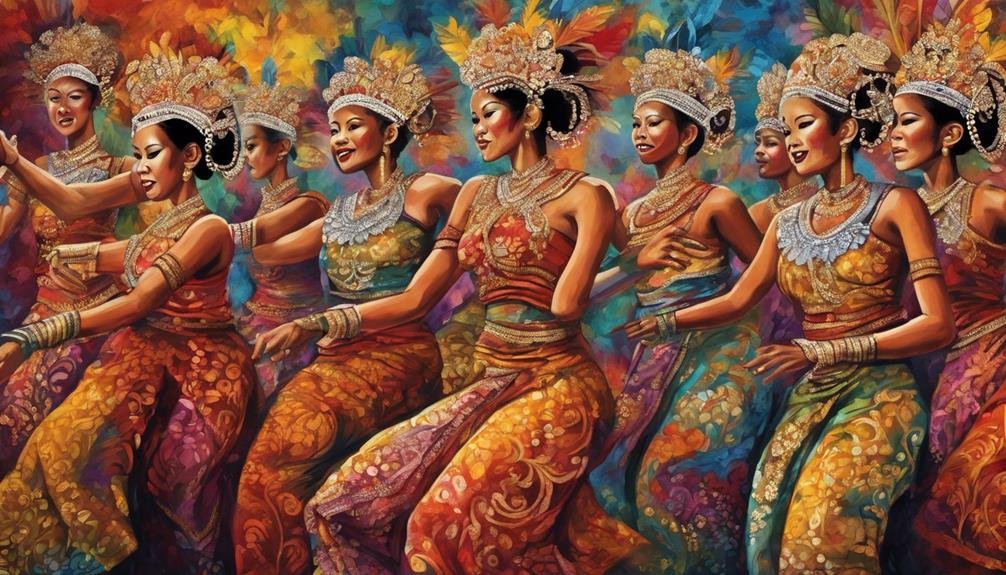
The Solo Batik Carnival in Indonesia greatly influences the local tourism industry, attracting a diverse array of visitors keen to experience the rich heritage of batik craftsmanship. This event not only showcases the cultural immersion of batik artisans but also has significant economic impacts on Surakarta.
- Economic Boost: The carnival contributes to the local economy by increasing tourism spending on accommodations, dining, and transportation, benefiting various sectors within the city.
- Cultural Immersion: Visitors are immersed in the cultural diversity and craftsmanship of batik artisans, promoting Surakarta as a vibrant cultural tourism destination.
- Tourist Attraction: The vibrant displays and performances during the carnival create a unique tourist attraction, enhancing the city's appeal to cultural enthusiasts worldwide.
- Support for Local Businesses: The increased tourist footfall during the carnival leads to economic benefits for local establishments like hotels, restaurants, and souvenir shops, fostering growth and sustainability in the community.
Future of Solo Batik Carnival
As the Solo Batik Carnival in Indonesia looks ahead, the focus shifts towards innovating costume designs and performance elements to enhance the vibrant celebration of Indonesian batik culture.
Innovative collaborations with local designers, artisans, and cultural groups are set to bring fresh perspectives to the carnival, ensuring spectacular showcases that captivate audiences.
The future of Solo Batik Carnival lies in its ability to continue celebrating Indonesian batik culture through creative and vibrant displays, attracting more participants and spectators to Solo as a cultural hub for batik artistry.
Frequently Asked Questions
Where Is the Solo Batik Carnival Held?
The Solo Batik Carnival, a vibrant cultural celebration, showcasing traditional clothing, is held in Solo, Indonesia. Participants parade along iconic streets, enchanting spectators with batik outfits and cultural performances, culminating at Balaikota Surakarta.
What Is Meant by Carnival Batik?
Carnival Batik refers to a festive celebration where individuals wear vibrant batik costumes, showcasing the artistry of traditional Indonesian batik. It's a way of celebrating tradition and cultural heritage through colorful clothing and parades.
The Solo Batik Carnival Is an Annual Festival Held by the Surakarta City Government Regularly. What Is the Purpose of the Government in Organizing the Festival?
In organizing a cultural celebration like the Solo Batik Carnival, the government purpose is to promote local heritage, foster community unity, and showcase creativity. Such events play an essential role in preserving traditions and connecting people.
What Is the Famous Batik Motif in Solo?
When in Solo, explore the famous batik motif, 'Parang Rusak,' with its traditional patterns and cultural significance. This design symbolizes power and protection with sharp, jagged lines, embodying strength, courage, and resilience in Javanese culture.
Conclusion
You've experienced the vibrant colors, intricate patterns, and rich cultural heritage of the Solo Batik Carnival in Indonesia.
This annual event not only showcases the beauty of batik but also celebrates the creativity and artistry of local designers.
The carnival's impact on tourism and promotion of local heritage make it a must-see cultural extravaganza for anyone looking to immerse themselves in the beauty of Indonesian traditions.
Don't miss out on this unique and colorful celebration!

